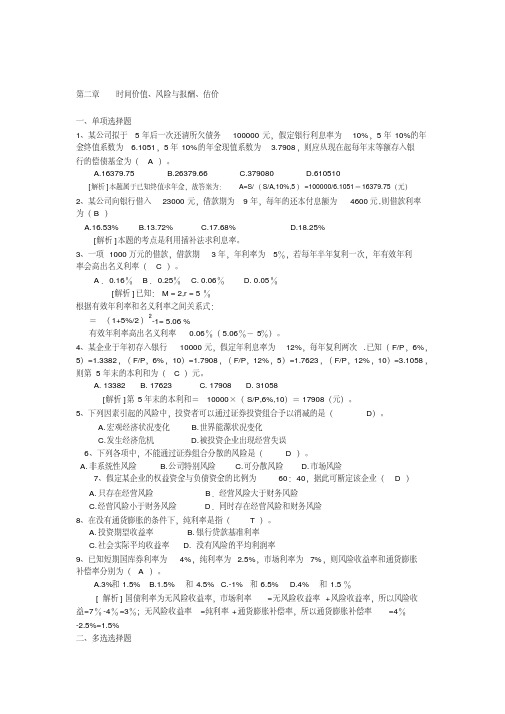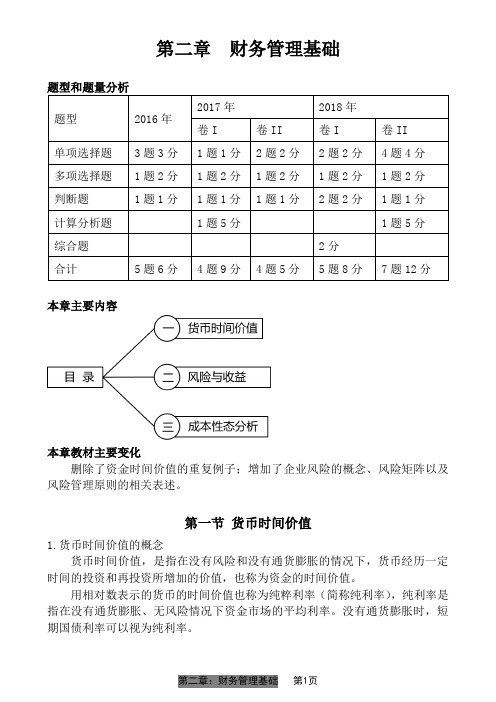财务管理第二章
财务管理第二章

第一节
• • • • • •
资金的时间价值
一、资金时间价值的概念 二、资金时间价值的计算 (一)单利的计算 (二)复利的计算 (三)年金的计算 三、时间价值计算中的特殊问题
第二节 风险报酬率
• • • • • • • 一、风险及风险报酬率的概念 二、风险的衡量 三、风险收益率 四、风险报酬的计算 五、风险对策 六、风险的规避 七、资本资产定价模型(了解)
• 案例所涉及到的问题
案例所涉及到的问题
• • • • 现值的概念 终值的概念 现值与终值如何计算 引申出时间价值的概念
一、资金的时间价值的概念
1.西方传统观点:它是在没有风险和没有通货膨胀条件下,
股东投资就牺牲了当时使用或消费的权利,按牺牲时间计算的代 价或报酬,称为资金时间价值。
2.凯恩斯观点:是投资者放弃灵活偏好所得到的报酬。 3.马克思观点:是工人创造剩余价值的一部分。
融资租赁费现值P=9.5×5.7466=54.5927万元 低于现在购买成本60万元,因此,应选择融资租赁方式。
思考:某人贷款购买轿车一辆,在六年内每年年 末付款26500元,当利率为5%时,相当于现在 一次付款多少?(答案取整)
解:
P=A•PVIFAi,n=26500×PVIFA5%,6=26500X5.0757 =134506 (元) 轿车的价格=134506元
方法二: 先算年金现值,再算复利现值
P = A × PVIFAi,n×PVIFi,m
eg.从第三年起每年收入1000元,其现值多少?
年金现值 (n-m) 复利现值 m 0 1 2 3
i=10%
n
4 5
方法1
P=AXPVIFAi,n-mXPVIFi,m =1000XPVIFA10%,3XPVIF10%,2 =1000X2.4869X0.8264=2055.17(元)
财务管理 第二章 习题

第二章财务管理价值观念作业一、单项选择题1.每股收益最大化与利润最大化相比,其优点在于()。
A.考虑了时间价值B.考虑了风险价值C.考虑了利润所得与投入资本的关系D.考虑了市场对公司的客观评价2.A方案在三年中每年年初付款500元,B方案在三年中每年年末付款500元,若利润为10%,则两个方案第三年年末时的终值相差[ ]A.105 B.165.5 C.665.5 D.5053、在10%利率下,一至五年期的复利现值系数分别为0.9091、0.8264、0.7513、0.6830、0.6209,则五年期的即付年金现值系数为()。
A.3.7907B.4.7907C.5.2298D.4.16984.预付年金现值系数和普通年金现值系数相比[ ]A.期数加1,而系数减1 B.期数减1,而系数加1C.期数和系数均加1 D.期数和系数均减15.下列因素引起的风险,企业可以通过多元化投资予以分散的是[ ]A.社会经济衰退B.市场利率下降C.研究开发新产品D.通货膨胀6.某人拟在5年后获得本利和10000元,投资报酬率为10%,现在应投入_____元。
[ ]A.6210 B.4690 C.4860 D.50007.某人出国3年,请你代付房租,每年年末付租金10000元,设银行存款复利率10%,他应当现在给你在银行存入____钱。
[ ]A.30000元B.24870元C.27000元D.39930元8.A方案在三年中每年年初付款100元,B方案在三年中每年年末付款100元,若利率为10%,则二者在第三年年末时的终值相差[ ]A.31.3 B.33.1 C.133.1 D.13.31 9.如果以10%的年利率借入10000元,投资于某寿命为5年的项目,为使该项目成为有利可图的项目,每年至少应收回的现金数额为[ ]A.4682元B.3000元C.1577元D.2638元10.三年分期付款购物,每年末支付500元,设银行利率为10%,该项分期付款相当于现在一次现金支付的购物价格为[ ]A.1243元B.1058元C.1818元D.1539元11.某学校拟建立一笔永久性的奖学金,以期在未来的时间里每年发放25000元的奖金,若当时的利率为8%,则现在应存入多少钱[ ]A.312500 B.247500 C.129500 D.363250 12.下列各项中,可视为纯利率的是()。
财务管理第二章配套练习及答案

第二章时间价值、风险与报酬、估价一、单项选择题1、某公司拟于5年后一次还清所欠债务100000元,假定银行利息率为10%,5年10%的年金终值系数为 6.1051,5年10%的年金现值系数为 3.7908,则应从现在起每年末等额存入银行的偿债基金为( A )。
A.16379.75B.26379.66C.379080D.610510[解析]本题属于已知终值求年金,故答案为:A=S/(S/A,10%,5)=100000/6.1051=16379.75(元)2、某公司向银行借入23000元,借款期为9年,每年的还本付息额为4600元,则借款利率为(B )A.16.53%B.13.72%C.17.68%D.18.25%[解析]本题的考点是利用插补法求利息率。
3、一项1000万元的借款,借款期3年,年利率为5%,若每年半年复利一次,年有效年利率会高出名义利率( C )。
A.0.16%B.0.25% C. 0.06% D. 0.05%[解析]已知:M = 2,r = 5%根据有效年利率和名义利率之间关系式:=(1+5%/2)2-1= 5.06 %有效年利率高出名义利率0.06%(5.06%-5%)。
4、某企业于年初存入银行10000元,假定年利息率为12%,每年复利两次.已知(F/P,6%,5)=1.3382,(F/P,6%,10)=1.7908,(F/P,12%,5)=1.7623,(F/P,12%,10)=3.1058,则第5年末的本利和为( C )元。
A. 13382B. 17623C. 17908D. 31058[解析]第5年末的本利和=10000×(S/P,6%,10)=17908(元)。
5、下列因素引起的风险中,投资者可以通过证券投资组合予以消减的是(D)。
A.宏观经济状况变化B.世界能源状况变化C.发生经济危机D.被投资企业出现经营失误6、下列各项中,不能通过证券组合分散的风险是( D )。
《财务管理》第二章》PPT课件

一、资金时间价值的概念
1、资金时间价值的含义
资金的时间价值,是指资金经历一定 时间的投资和再投资所增加的价值,也即资金在 周转中由于时间因素而形成的差额价值。
●要点解释:
(1)增量,用“增值金额/本金”表示; (2)要经过投资与再投资; (3)要持续一段时间才能增值; (4)随着时间的延续,货币总量在循环周转中 按几何级数增长,使货币具有时间价值。
3、如何处置资金时间价值
按复利的方法折算不同时间货资金的现值。
4、资金时间价值量的衡量
通常情况下,资金时间价值被认为是 没有风险和没有通货膨胀下的社会平均利润率 。
资金时间价值量的大小通常可以用利 息率来表示,但这种利息率应以社会平均资金 利润率为基础,并且以社会平均利润率作为资 金时间价值量的最高界限。
永续年金现值 P=A/i (资本化)
没有终值。
名义利率 实际利率
名义利率=每期利率×年内复利次数
实际利率
1
名义利率
年内复利次数
年内复利次数
1
每季度利率为2%, 年内复利次数4次, 故:名义利率 =2%×4=8%
(一)复利现值的计算
【 例1】 B公司股票现在市场价格为38元 ,市场价格的年平均增长率为5%,上年每股股利 为0.83元,股利的年平均增长率为4%。如果你手 中有一笔钱想购买B公司的股票,假设投资期限为 一年(年初至年末),期望获得10%以上的收益, 请问你在何种价位购买为宜?
二、资金时间价值的计算与应用
名称 计算 方 法
复利终值 复利现值 年金终值
年金现值
S=P×(1+i)n(基本公式)
=P×(S/P,i,n)
《财务管理学》第二章财务管理的价值观念

价值观念的重要性
价值观念对于财务管理人员在进行财务决策时具有重要影响。正 确的价值观念能够帮助财务管理人员做出更加科学、合理和有效 的决策,提高企业的经济效益和社会效益。
财务管理中价值观念的应用
01
风险与收益的权衡
在财务管理中,风险和收益的权衡是重要的价值观念之一。财务管理人
员需要正确评估风险和收益的关系,以实现企业价值的最大化。
资源来促进社会和环境的可持续发展。
THANK YOU
感谢聆听
02
是指在不同时间点上,等额货币的价值不等,随着时间的推移, 货币的价值会增长。
计算
货币的时间价值通常通过现值和终值的计算来体现。现值是指未来某一时点的 现金流量折现到现在的价值,而终值则是指现在某一时点的现金流量在未来某 一时点的价值。
复利与年金
复利
债务与权益的权衡
在融资决策中,企业需权衡债 务和权益融资的优缺点,以确 定最优的融资方式。
企业分配决策中的价值观念
利润分配政策
01
企业需制定合理的利润分配政策,以满足股东的利益诉求和企
业的可持续发展。
股东财富最大化
02
企业应以股东财富最大化为目标,制定合理的股利分配方案。
社会责任
03
企业在追求经济效益的同时,应关注社会责任,通过合理分配
时间价值的特殊情况
通货膨胀
通货膨胀是指货币的购买力下降,物 价上涨。在通货膨胀的情况下,货币 的时间价值需要考虑通货膨胀率的影 响。
不确定性
不确定性是指未来的现金流量和时间 的不确定性。在不确定性较高的情况 下,货币的时间价值需要更加谨慎地 考虑风险和收益的平衡。
03
风险与报酬的权衡
风险的定义与分类
财务管理学第二章

永续年金的计算
四.永续年金(特点:没有终值的年金,是 普通年金的特殊形式) 永续年金是指无限期支付的年金 V=A*1/i
几个特殊问题
五.时间价值计算中的几个特殊问题 1.不等额现金流量现值的计算 例:有一组现金流量分别为第一年年末为200,
第二年年末为300,第三年年末为150. 贴现率 为5%, 这组现金流量的现值之和是多少? PV=200*PVIF5%,1+300*PVIF5%,2+150*PVIF5%,3=
货币时间价值
例 :A企业购买一台设备,采用付现方式
,其价款40万元。如延期5年后付款,则价 款52万元,假设5年期存款利率为10%。试 问现付和5年后付款,哪个更有利?
货币时间价值
5年期存款:
40*10%*5+40=60万元
显然延期付款有利。
财务管理的价值观念
一、资金的时间价值的概念
延期年金现值的计算
0 +n
1
2
1
m m+1 m+2 m+
+---+---+---+---+---+---+---+---+
两种计算方法: V=A*PVIFAi,n*PVIF 两种计算方法:i,m
⑴
V=A*(PVIFAi,m+n - PVIFAi,m)
V=A*PVIFAi,n * PVIFi,m
例:某人准备在第5年末获得1000元收入,年利息率为 10%,计算:
(1)每年计息一次,问现在存入多少钱?
(2)每半年计息一次,现在应存入多少钱? (1)PV=1000*PVIF10%,5=621元
中级会计职称:财务管理第二章已讲内容

第二章财务管理基础第一节货币时间价值一、货币时间价值的含义(一)含义在没有风险和没有通货膨胀的情况下,货币经历一定时间的投资和再投资所增加的价值,也称为资金的时间价值。
(二)货币时间价值量的规定性用相对数表示的货币的时间价值也称为纯粹利率(纯利率)。
纯粹利率是指没有风险也没有通货膨胀情况下的社会平均利润率。
【例题•单选题】下列哪些指标可以用来表示资金时间价值()。
A.企业债券利率B.社会平均利润率C.通货膨胀率极低情况下的国债利率D.无风险报酬率【答案】C【解析】资金时间价值是无风险、无通货膨胀下的社会平均利润率。
二、复利终值和现值(一)利息的两种计算方法单利计息:只对本金计算利息,各期利息相等。
复利计息:既对本金计算利息,也对前期的利息计算利息,各期利息不同。
(二)复利终值与现值的计算终值(FutureValue)是现在的一笔钱或一系列支付款项按给定的利息率计算所得到的在未来某个时间点的价值。
现值(PresentValue)是未来的一笔钱或一系列支付款项按给定的利息率计算所得到的现在的价值。
1.复利终值【教材例2-1】某人将100元存入银行,复利年利率10%,求1年后、2年后的本利和。
(1)复利终值的计算公式:复利终值系数表1元的复利终值系数,利率i,期数n,即(F/P,i,n)。
【扩展教材例2-1】某人将100元存入银行,复利年利率10%,求5年后的本利和。
【解析】F=P(1+i)n=100×(l+10%)5或:F=P×(F/P,i,n)=100×(F/P,10%,5)=100×1.6105=161.05(元)基本公式不变,只不过将年利率调为期利率(r/m),将年数调为期数。
【教材例2-2】某人将100元存入银行,年利率4%,半年计息一次,按照复利计算,求5年后的本利和。
【解析】F=P×(1+2%)10或:F=P×(F/P,2%,10)=100×(F/P,2%,10)=121.90(万元)【例题•单选题】某企业于年初存入银行10000元,假定年利率为12%,每年复利两次。
财务管理-第二章--财务管理的价值观念

复利终值公式:FV=PV(1+i)n
其中 FV ―复利终值; PV―复利现值; i―利息率; n―计息期数; (1+i)n为复利终值系数,记为FVIFi,n或(F/P,i,n)
FV=PV ·FVIFi,n
某企业为开发新产品,向银行借款100 万元,年利率为10%。借款期限为5年,问 5年后一次归还银行的本利和是多少?
FA=A·FVIFA8%,5 =A(F/A,8%,5) =100×5.8666=586.66(元)
拟在5年后还清100000元债务,从现在起每年等额存入银 行一笔款项。假设银行存款利率为10%,每年需要存入多少元?
已知:5年后的终值10万元,求A? F=A(F/A,i,n) A=F / (F/A,i,n)
2000 2000 2000 2000 2000
0
1
2
3
4
5 年末
这是期限为5年每年收入2000元的普通年金的现金流
0
1
2
3
4
5 年初
3000 3000 3000 3000 3000 这是期限为5年每年支付为3000元的预付年金的现金流
年金案例
• 学生贷款偿还 • 汽车贷款偿还 • 保险金 • 抵押贷款偿还 • 养老储蓄
•关系:利率一年内复利多次时,实际利率大于名义 利率, 假设r—名义利率;M—每年复利次数;i—实
际利率
•第一年末 F=P×(1+r/M)M
•
I=P ×(1+r/M)M-P=P[(1+r/M)M-1]
•
i= I/P=(1+r/M)M –1
•接上题:
• F=P×(1+r/M)M = 100(F/P,5%,4)
《财务管理》第二章:财务管理基础【货币时间价值】

第二章财务管理基础本章主要内容本章教材主要变化删除了资金时间价值的重复例子;增加了企业风险的概念、风险矩阵以及风险管理原则的相关表述。
第一节货币时间价值1.货币时间价值的概念货币时间价值,是指在没有风险和没有通货膨胀的情况下,货币经历一定时间的投资和再投资所增加的价值,也称为资金的时间价值。
用相对数表示的货币的时间价值也称为纯粹利率(简称纯利率),纯利率是指在没有通货膨胀、无风险情况下资金市场的平均利率。
没有通货膨胀时,短期国债利率可以视为纯利率。
2.复利终值和现值利息有两种计算方法:单利计息和复利计息。
单利计息是指按照固定的本金计算利息的一种计息方式,即只对本金计算利息,各期利息相等。
复利计息是指不仅对本金计算利息,且本期的利息从下期开始也要计算利息的一种计息方式,俗称“利滚利”,各期利息不同。
【例题】A将1000元本金存入银行,利率3%,期限3年,求按单利计算的利息。
【答案】按单利计算的利息=1000×3%×3=90元【解析】按单利计算利息时,只对本金1000元计算利息,每年的利息是相等的,都是1000×3%=30元,故3年的利息是30×3=90元。
【例题】A将1000元本金存入银行,利率3%,期限3年,求按复利计算的利息。
【答案】按复利计算的利息=1000×3%+1000×(1+3%)×3%+1000×(1+3%)(1+3%)×3%=92.73元【解析】按复利计算利息时,第一年只对本金1000元计算利息,第二年对本金1000元和第一年的利息再计算利息,第三年对本金1000元和第一、第二年的利息再计算利息,每年的利息不相等。
(1)复利终值终值是指现在一定量的货币按给定的利息率折算到未来某一时点所对应的金额。
复利终值指现在的特定资金按复利计算方法,折算到将来某一时点的价值。
也可以理解为,现在的一定本金在将来一定时间,按复利计算的本金与利息之和,简称本利和。
财务管理学课件(第二章)

(2)先付年金的终值和现值
A、终值
比普通年金终值计算加一期,减A
B、现值
比普通年金终值计算减一期,加A
(3)递延年金的终值和现值 A、终值 与普通年金计算一样 递延年金的现值与 普通年金一样吗?
B、现值
递延年金的现值
0 1 2
m A m+1 m+2 m+n-1 m+n
A
A
A
A
P=A· (P/A,i· n)
相比,将多得多少钱?
例题解答
30年后的终值FVA=500×FVIFA(5%,30)
=500×66.4388=33219.42
利息=33219.42-15000=18219.42
例题
某项目在营运后各年的现金流量如下(单 位:万元),贴现率为10%。
1 2 3 4 5 6 7 8
100 100 100 200 200 150 150 150 •根据你的理解,此项目的总回报是多少?
甲
500 乙 -1000
400
300
200
100
选择甲还是乙?
二、时间价值的计算
单利(Simple interest):在规定的时间内,对 本金计算利息 复利(Compound interest)在规定的时间内, 对本金和产生的利息计算利息 例:100元,按10%的单利存2年: 本利和=P+SI=P+P*i*n=100+100*10%*2=120 按10%的复利存2年: 本利和 =(P+P*i)(1+i)=100(1+10%)(1+10%)=121 时间价值的计算一般采用复利的概念
财务管理学第二章重难点

2-1.[识记]简述时间价值的概念及表现形式?一、时间价值是指一定量的资本在不同时点上的价值量的差额.时间价值来源于资本进入社会再生产过程后的价值增值,是资本在使用中产生的,是资本所有者让渡资本使用权而参与社会财富分配的一种形式。
时间价值有相对数和绝对数两种表示方式.实际工作中,可以用通货膨胀率很低时的政府债券利率来表示时间价值。
一般情况下,时间价值通常用相对数表示。
二、时间价值的表现形式1、现值(1)未来某一时点的一定量资本折合到现在的价值。
(2)现在的本金。
通常记作“P”.2、终值又称将来值,是现在一定量的资本在未来某一时点的价值,即未来的本利和。
通常记作“F”。
2-2[应用]如何计算单利终值与现值?例1:某人于20X5年1月1日存入中国建设银行10000元人民币,存期5年,存款年利率为5%,到期本息一次性支付。
求到期单利终值与利息是多少?例2:某人3年后将为其子女支付留学费用300000元人民币,20X5年3月5日,他将款项一次性存入中国银行,存款年利季4。
5%,则此人应存款的额数是多少?时间价值一般用利率来表示。
利息的计算通常包含单利和福利两种形式。
单利是只对本金计算利息。
即资本无论期限长短,各期的利息都是相同的,本金所派生的利息不再加入本金计算利息。
(1)单利终值单利重视是指一定量的资本在若干期以后包括本金和单利利息在内的未来价值。
单利终值的计算公式为:F=P+P n r=P(1+n r)单利利息的计算公式为:I=P n r式中:P是现值(本金);F是终值(本利和);I是利率;r是利率;n是计算利息的期数。
在例1中:单利终值=10000(1+5)=12500(元)利息=p=2500(元)(2)单利现值单利现值是指未来某一时点取得或付出的一笔款项,按一定折现率计算的现在的价值。
单利现值的计算公式为:P=F/(1+n)现值的计算与终值的计算是互逆的,由终值计算现值的过程为折现,这时的利率称为折现率,相应的计算期数称为折现期数。
李海波-财务管理-第二章-习题与答案

第二章财务价值计算基础〔一〕单项选择题1.金时间价值的实质是( )。
A.息率B资金周转使用后的增值额C.利润率D差额价值2.在实务中,人们习惯用( )表示货币时间价值。
A.绝对数B.相对数C.平均数D.指数3.永续年金具有以下特点( )。
A.每期期初支付B每期不等额支付C.没有终值D没有现值4.普通年金终值系数的倒数称之( )。
A. 偿债基金B. 偿债基金系数C.年回收额D.投资回收系数5.根据资金时间价值理论,在普通年金现值系数的基础上,期数减1、系数加1的计算结果,应当等于( )。
A.递延年金现值系数B.后付年金现值系数C.先付年金现值系数D.永续年金现值系数6年底存款100元,求第二年年末的价值,可用( )来计算。
A. PVIF i,nB. FVIF i,nC.PVIFA i,n D .F VIFA i,n7项目中的( )称为普通年金。
A.先付年金 B 后付年金C.递延年金D.永续年金8. 100元钱存入银行,利息率为10%,计算5年后的终值应用( )来计算。
A复利终值系数B.复利现值系数C.年金终值系数D.年金现值系数9.每年年底存款100元,求第5年末的价值,可用( )来计算A. PVIF i,nB. FVIF i,nC. PVIFA, i,nD. FVIFA. i,n10.以下项目中的( )称为普通年金。
A.先付年金B. 后付年金C.延期年金D. 永续年金方案在三年中每年初付款200 元,B方案在三年中每年年末付款200元,假设利率为10%,则二者在第三年年末时的终值相差( )。
A. 66.2B. 62.6C.266.212.假设最初有m期没有收付款项,后面n期有等额的收付款项,贴现率为i,则此笔延期年金的现值为( )。
A V o =A×PVIFA i,n B. V o =A×PVIFA i,,mo =A xPVIFA i,m+n D. V o=A×PVIFA i,,n×PVIF i,,m13.一项100万元借款,借款期限为3年,年利率为8 010,每半年复利一次,则实际利率比名义利率高( )。
财务管理第二章

财务管理第二章
3、风险的计量
(3)标准差-
(4)标准差系数——衡量风险
PPT文档演模板
财务管理第二章
标准差
标准差:以绝对数衡量投资项目的风 险,在期望值相同的情况下,标准 差越大,风险越大,反之亦然。
标准差系数:在期望值不同的情况下, 标准差系数越大,风险越大,反之 成立。
PPT文档演模板
财务管理第二章
PPT文档演模板
财务管理第二章
证券投资组合的策略与方法
策略
v 保守型策略 v 冒险型策略 v 适中型策略
PPT文档演模板
财务管理第二章
方法
v 选择足够数量的证券进行组合 v 把不同风险程度的证券组合在一起
v 把投资收益呈负相关的证券组合在一 起。
PPT文档演模板
财务管理第二章
财务决策按风险的程度分类
9%
6.418
PPT文档演模板
财务管理第二章
资金时间价值的几个特殊问题
贴现率的计算
8%
6.710
? x% 1%
6.667 0.043 0.292
9%
6.418
x/1% = 0.043/0.292
x = 0.147 求得利息率为:8% + 0.147% = 8.147%
PPT文档演模板
财务管理第二章
多个可加权平均,单个由证券服务机构给出。
证券组合的综合系数
PPT文档演模板
财务管理第二章
美国几家公司2011年3月16日的β系数
公司名称
β系数
雀巢
0.55
星巴克
1.26
谷歌
1.19
AT&T
0.66
耐克
《财务管理第二章》PPT课件

FV5=1000 ×(1+10% ×5)=15000(元)
• 2、单利现值
•
PV=FVn/(1+ni)
• 例2:某公司打算在3年后用60000元购置新
设备,目前的银行利率为5%,则公司现在
应存入:
PV=60000/(1+5% ×3)=52173.91(元)
– 某人存款2500元,年利率为8%,半年按复利计息一 次,试求8年后的本利和。
F2500(18% )164682.45 2
• 例:Harry以12%的名义年利率投资5000美元,按季复 利计息,那末他的资金五年后会变为多少?
[1 (0.12)]45 4
• 名义利率与实际利率:
– 名义利率只有在给出计息间隔期的情况下才有意义。 – 如若名义利率为10%,1美元每半年按复利计息情况下,
PVAn=A×[1-(1+i)-n]/i=A/i • 例:一项每年年底的收入为800元的永续年金投资,
利率为8%,则其现值为多少?
5、时间价值计算中的几个特殊问题
A、不等额现金流量现值的计算:
• 不等额现金流的终值计算公式: FVn=∑Ct(1+i)t
• 不等额现金流的现值计算公式: PVn=∑Ct/(1+i)t
• 2.若麦克每年拿出工资的5%,以利率8%存款,到 他60岁时,存款为多少?
• 3.若麦克打算在此后5年里等额消费这笔存款,每 年他可消费多少?
第二节风险衡量与风险报酬
• 问题引入: • 若买地要200万元,建造楼房要花费200
万元,但你的房地产顾问并不能肯定该 楼房未来的价值一定是420万元,而若 此时你可以花4 00万元购买政府债券从 而保证获得4 2万元收入时,你还会投资 建造楼房吗?
财务管理学第二章财务管理价值观念

V 0 10 • (P 0V 0 8 % 2I 0 ,P FV A 8 % 1) I 0 , 1 F0 A (9 .0 8 0 1 6 .7 8 )1 31 (元 )08
财务管理学
21
2.1 货币时间价值
4、永续年金现值的计算 永续年金是指期限为无穷的年金。绝大多数优先股因为有固定的股利而又无到期日,因而其股利也 可以视为永续年金。另外,期限长、利率高的年金现值,可以按永续年金现值的计算公式计算其近 似值。 永续年金现值的计算公式为:
P V Fn• V (1 1 i)n20 (1 0 8 1 0 % 3 )15 (元 8 ) 8
P V F n V P8 V % 3 ,2 IF 0 0 .7 0 9 1 04 ( 5 元 )88
财务管理学
9
2.1 货币时间价值
➢ 2.1.4 年金终值和现值 年金是指一定时期内每期相等金额的收付款项。折旧、利息、租金、保险费等均表现为年金形式。 年金按付款方式,可分为后付年金(普通年金)、先付年金(即付年金)、延期年金和永续年金。
V0
A
•
1 i
财务管理学
22
2.1 货币时间价值
例2—8 一项每年年底的收入为800元的永续年金投资,利息率为8%,其现值为: ➢ 2.1.5 时间价值计算中的几个特殊问题
1其、现不值等计额算现公金式流为量:现值V 的0 计算80081 %100(元 0)0
P0V A 0(1 1i)0A 1(1 1i)1A 2(1 1i)2...A n1(11 i)n1A n(1 1i)n
At1(1i)t
n 1
t 1 (1 i ) t
PVIFAi,n
ADF i , n
财务管理学
13
- 1、下载文档前请自行甄别文档内容的完整性,平台不提供额外的编辑、内容补充、找答案等附加服务。
- 2、"仅部分预览"的文档,不可在线预览部分如存在完整性等问题,可反馈申请退款(可完整预览的文档不适用该条件!)。
- 3、如文档侵犯您的权益,请联系客服反馈,我们会尽快为您处理(人工客服工作时间:9:00-18:30)。
Depreciation
Depreciation represents the systematic allocation of the cost of a capital asset over a period of time for financial reporting purposes, tax purposes, or both.
The Business, Tax, and Financial Environments
• • •
The Business Environment
The Tax Environment
The Financial Environment
The Business Environment
The US has four basic forms of business organization:
• •
Oldest form of business organization. Business income is accounted for on your personal income tax form.
Summary for Sole Proprietorship
Advants Environment
Partnership – A business form in which two or more individuals act as owners.
•
Business income is accounted for on each partner’s personal income tax form.
• Limited liability • Centralized management
• Unlimited life
• Transfer of ownership without other owners’ prior consent
Summary for LLC
Advantages
• •
Disadvantages
•
Generally, profitable firms prefer to use an accelerated method for tax reporting purposes.
Common Types of Depreciation
• Straight-line (SL)
• Accelerated Types
• Double Declining Balance (DDB) • Modified Accelerated Cost Recovery System (MACRS)
•
• •
Relatively quick setup
Limited liability for limited partners
•
The Business Environment
Corporation – A business form legally separate from its owners.
• •
An artificial entity that can own assets and incur liabilities. Business income is accounted for on the income tax form of the corporation.
Summary for Corporation
Income Tax Example
Lisa Miller of Basket Wonders (BW) is calculating the income tax liability, marginal tax rate, and average tax rate for the fiscal year ending December 31. BW’s corporate taxable income for this fiscal year was $250,000.
Summary for Partnership
Advantages
• •
Disadvantages
•
Can be simple Low setup cost, higher than sole proprietorship
Unlimited liability for the general partner Difficult to raise additional capital, but easier than sole proprietorship Transfer of ownership difficulties
•
Limited liability
Eliminates double taxation
Limited life (generally)
•
•
No restriction on number or type of owners
Easier to raise additional capital
Transfer of ownership difficulties (generally)
•
Disadvantages
•
•
Simplicity
Low setup cost
Unlimited liability
Hard to raise additional capital Transfer of ownership difficulties
•
•
Quick setup
Single tax filing on individual form
•
Business income is accounted for on each “member’s” individual income tax form.
Limited Liability Company (LLC)
Generally, an LLC will possess only the first two of the following four standard corporation characteristics
•
•
•
Easier to raise large quantities of capital
The Business Environment
Limited Liability Companies – A business form that provides its owners (called “members”) with corporatestyle limited personal liability and the federal-tax treatment of a partnership.
•
Corporate Income Taxes
Corp. Taxable Income At Least But < $ 0 $ 50,000 50,000 75,000 75,000 100,000 100,000 335,000 335,000 10,000,000 10,000,000 15,000,000 15,000,000 18,333,333 18,333,333 Tax Rate 15% 25% 34% 39% 34% 35% 38% 35% Tax Calculation 0.15x(Inc > 0) $ 7,500 + 0.25x(Inc > 50,000) 13,750 + 0.34x(Inc > 75,000) 22,250 + 0.39x(Inc > 100,000) 113,900 + 0.34x(Inc > 335,000) 3,400,000 + 0.35x(Inc > 10,000,000) 5,150,000 + 0.38x(Inc > 15,000,000) 6,416,667 + 0.35x(Inc > 18,333,333)
• • •
Sole Proprietorships
Partnerships (general and limited)
Corporations
•
Limited liability companies
The Business Environment
Sole Proprietorship – A business form for which there is one owner. This single owner has unlimited liability for all debts of the firm.
Chapter 2
The Business, Tax, and Financial Environments
After studying Chapter 2, you should be able to:
1.
2.
3.
4.
5.
6. 7.
Describe the four basic forms of business organization in the United States – and the advantages and disadvantages of each. Understand how to calculate a corporation's taxable income and how to determine the corporate tax rate - both average and marginal. Understand various methods of depreciation. Understand why acquiring assets through the use of debt financing offers a tax advantage over both common and preferred stock financing. Describe the purpose and make up of financial markets. Demonstrate an understanding of how letter ratings of the major rating agencies help you to judge a security’s default risk. Understand what is meant by the term “term structure of interest rates” and relate it to a “yield curve.”
